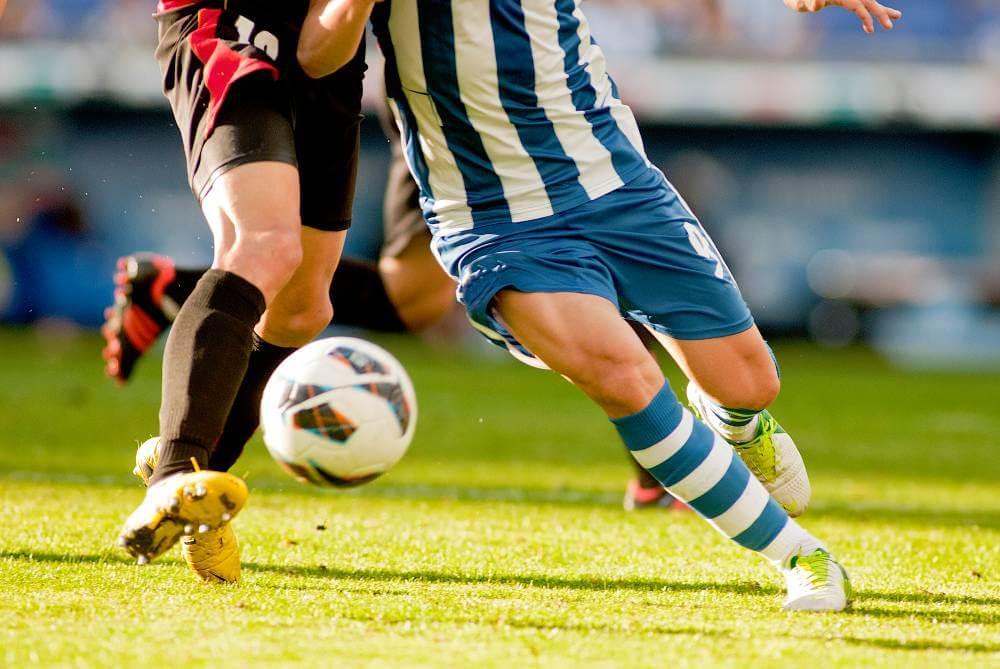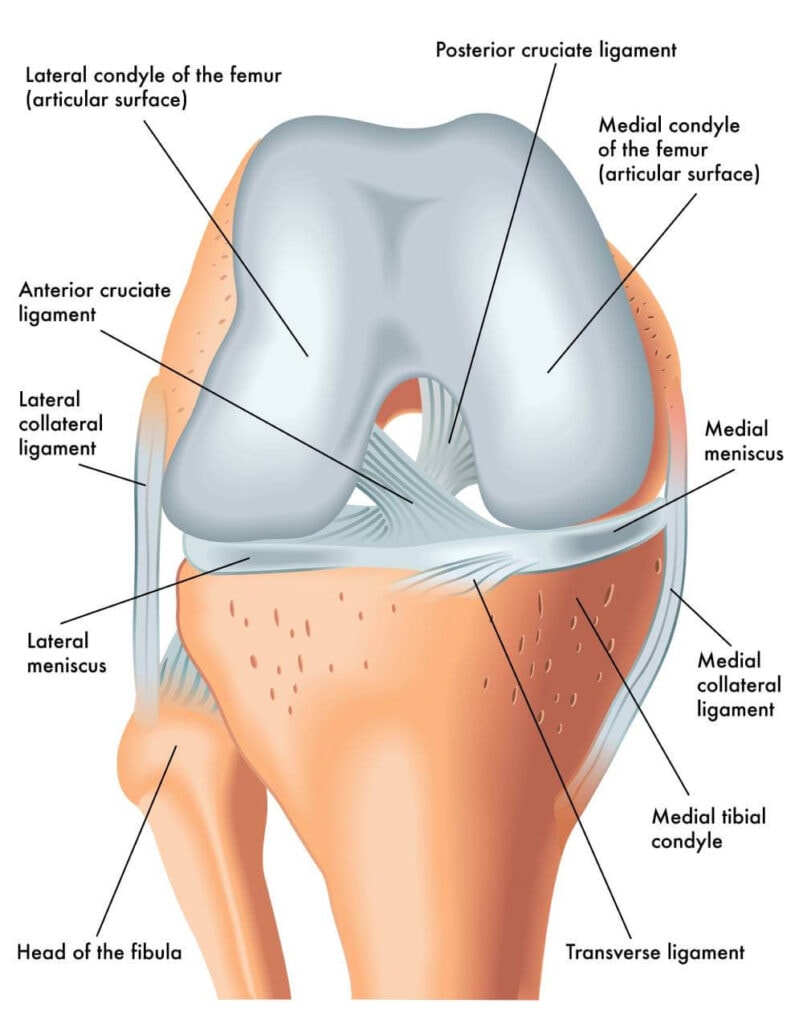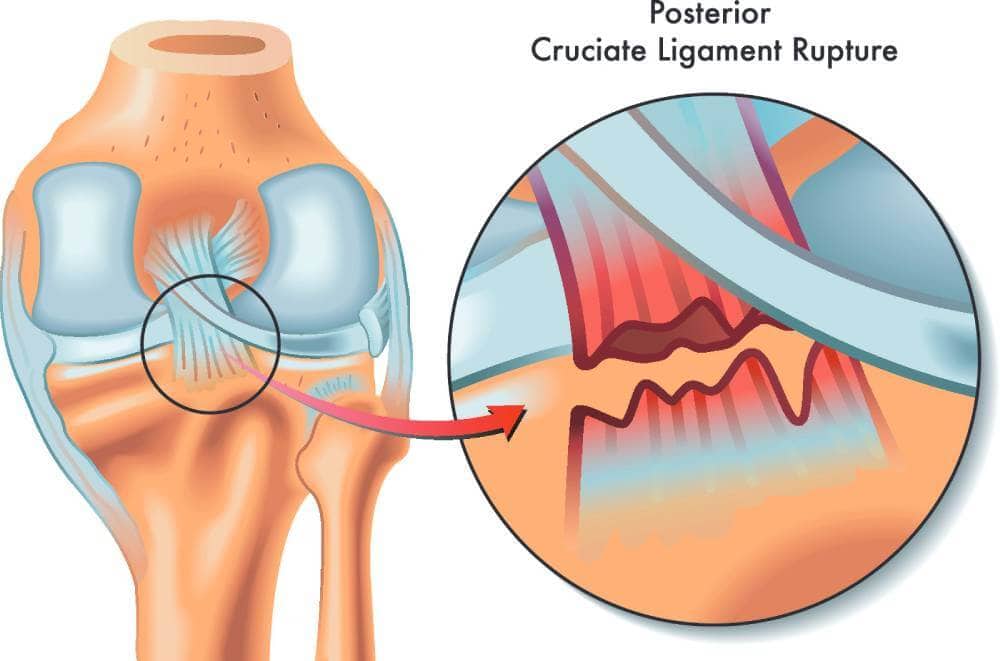PCL Tear – Everything You Need to Know

Medically Reviewed By:

The posterior cruciate ligament (PCL) is one of four main ligaments in the knee. It controls movements, prevents injuries like dislocations, and provides stability. PCL tears or ruptures can result from traumatic injuries such as car accidents or sports activities. Symptoms include swelling, pain, and knee instability.
Common treatments include pain medications, bracing, and at-home remedies. When these fail, or if the tear is severe, patients are sometimes recommended surgery. However, when considering different treatment options, it’s important to know that, depending on the severity of the tear, the PCL may be able to heal on its own.
The Regenexx approach offers patients a less invasive alternative that reduces the need for surgery or long-term use of prescription drugs.
What Is the Posterior Cruciate Ligament?
The knee is a complex joint that connects the thigh bone (femur), the shin bone (tibia), and the kneecap (patella). Tendons and ligaments hold these bones in place and connect them to surrounding muscles.
There are four main ligaments in the knee:
- Anterior cruciate ligament (ACL): Prevents the tibia from moving too far forward relative to the femur. It also ensures stability during rotational movements.
- Posterior cruciate ligament (PCL): Prevents the tibia from sliding backward beneath the femur. It is critical to the stability of the rear aspect of the knee.
- Medial collateral ligament (MCL): Protects the knee from inward bending.
- Lateral collateral ligament (LCL): Protects the knee from outward bending and external forces.

The PCL is located behind the ACL. These two ligaments form a crisscross structure at the back of the knee. The position of this ligament makes it important for joint stability during backward movements or when suddenly coming to a stop from running.
PCL injuries are less common than ACL injuries but can be just as serious.
What Is a Torn PCL?
A PCL tear occurs when the ligament becomes partially or completely torn. This can result from trauma, such as a direct blow to the front of the knee. It can also happen due to extreme hyperextension. Hyperextension occurs when the knee is pushed backward beyond its normal range of motion, overstretching and damaging ligaments.
A torn PCL no longer provides support to keep the tibia and the femur in place. This compromises knee stability and makes performing daily activities or engaging in sports difficult.
PCL tears remain a relatively rare injury that affects an estimated two in 100,000 persons. However, it is important not to underestimate the impact of PCL injuries because:
- PCL injuries tend to occur alongside other injuries of the knee. These include ACL tears, meniscal tears, fractures, or dislocations.
- 2018 research shows that, left untreated, PCL tears can increase the risk of complications. These include subsequent meniscus tears, early-onset knee osteoarthritis, chronic knee problems, and re-injuries.
How Do Physicians Categorize PCL Tears?
Physicians categorize PCL injuries based on the extent and nature of the tear:
- Partial tear: Only some fibers of the posterior cruciate ligament (PCL) are damaged.
- Complete tear: The ligament is entirely severed.
Additionally, tears are classified as follows:
- Retracted tear: The ends of the torn ligament pull away from each other, often requiring more complex treatment.
- Non-retracted tear: The ends remain relatively close, typically leading to an easier healing.
Healthcare professionals also assign grades to describe the severity of the injury and guide treatment:
- Grade 1: This is a mild sprain where the PCL becomes stretched but not torn. The ligament fibers remain fairly aligned and intact. Patients usually experience minimal swelling and pain. The knee retains most of its stability and functions relatively well.
- Grade 2: This involves a partial tear of the PCL. These injuries can be either non-retracted if the fibers remain aligned or mildly retracted. Symptoms include moderate pain and swelling. There can be noticeable instability in the knee. In Grade 2 tears, activities that require rapid direction changes become challenging.
- Grade 3: This injury indicates a complete ligament tear or rupture. The ligament is entirely severed. The ligament fibers are usually retracted, resulting in significant knee instability. This causes the joint to “give out” or buckle during activities.
- Grade 4: This is the most severe form of PCL tear. It is a complete tear that occurs alongside damage to other knee components. These may include other ligaments, cartilage, or bones. It often requires complex treatments to address multiple damaged areas and restore function.

Diagnosing the severity and nature of a PCL tear can be challenging due to the ligament’s location. Additionally, chronic PCL ruptures, which are complete tears, can sometimes be missed on MRI scans.
To improve diagnostic accuracy and guide informed treatment decisions, physicians within the licensed Regenexx network may use SANS evaluation to provide an analysis of joint health.
During evaluation, the physician will review existing MRIs and scans and examine your body in motion. This specialized evaluation method may also use advanced diagnostic tools such as ultrasound to determine the causes of pain.
Potential Causes of Tears in the PCL
Tears in the posterior cruciate ligament (PCL) can result from significant force, external or internal, applied to the knee. This force damages the joint’s components or causes the ligaments to stretch beyond their normal range of motion.
Sports Injuries
Participating in sports such as football, soccer, and skiing can increase the risk of knee ligament injuries. These include isolated PCL tears, isolated ACL tears, and PCL tears associated with ACL tears.
A single misstep isn’t likely to cause damage to the PCL. However, sports that involve direct contact, rapid changes of direction, jumps, or tackles can put excessive stress on the knee. This can increase the risk of PCL tears by:
- Receiving a direct blow to the knee when colliding with another player
- Landing awkwardly and hard on one foot after a jump
- Performing a forceful twisting movement when changing directions rapidly
- Falling on a bent knee
- Hyperextending the knee
Accident or Trauma
PCL tears can also occur in motor vehicle accidents. This usually happens when a passenger’s bent knee hits the dashboard during a collision. The external force can push the shin backward, causing the PCL to overstretch or tear. This is known as a “dashboard knee injury.” It is a fairly common injury in road traffic accidents.
A direct impact, such as falling on the knee or colliding with an object can also cause the PCL to tear.
Symptoms of Tears in the PCL
PCL tears are characterized by symptoms like pain, swelling, lack of mobility, and instability. These symptoms are common in several other knee injuries, such as meniscus or ACL tears. Because of this, an accurate diagnosis is required to identify a PCL tear and exclude other possible causes of pain.
Intense Pain
Pain is often the first indicator of a PCL tear. Nerve endings in the injured knee send distress signals to the brain, which are felt as pain. The body’s inflammatory response also kicks in. It sends cytokines and other inflammatory mediators to the injured area. This increase in inflammatory substances intensifies pain and causes other symptoms associated with inflammation, like swelling.
Pain from a torn PCL can be a sharp, acute sensation immediately following the injury. Over time, it can become persistent, throbbing discomfort. The intensity of the pain will vary depending on the severity of the injury. It is also more intense if there are other types of damage to the knee, like dislocations or fractures.
Swelling
Swelling occurs when the body directs fluids to the injured area to contain the damage, prevent complications such as infections, and begin the healing process. These fluids include plasma and blood containing inflammatory agents like neutrophils. The swelling usually becomes noticeable in the hours after the injury. It can be localized at the back of the knee but can spread to nearby locations.
Stiffness
The actions causing stiffness in PCl tears include:
- Accumulation of fluid in and around the joint limits the knee’s range of motion.
- Pain may make movements undesirable.
- Muscle spasms around the knee can contribute to a feeling of stiffness. These occur when the body attempts to stabilize the injured knee.
Lack of Mobility
The combination of pain, swelling, and stiffness results in a noticeable lack of mobility. This makes it difficult to bend or fully straighten the knee. The loss of normal joint mechanics can also make simple activities like walking or climbing stairs difficult. This symptom is particularly noticeable when many ligaments or knee structures are affected.
Knee Instability
The PCL helps stabilize the tibia and femur, preventing them from shifting out of place. When this ligament is damaged, these bones can slide out of position. This causes instability, buckling, and a sensation of the knee “giving way.” It becomes particularly noticeable during rapid direction changes or weight-bearing activities.
Isolated PCL tears rarely cause long-term functional problems. However, one study found that 26% of patients with this injury reported residual instability.
Common Treatments Used for Torn PCL
Minor PCL tears resolve on their own, thanks to the ability of the ligament to heal naturally. The treatments might help ease pain and support the knee during recovery.
Generally, surgery tends to be considered the last resort for complete or severely retracted PCL tears. These may cause pain and instability that don’t respond to other treatments and cause disability.
RICE Method
The RICE (rest, ice, compression, elevation) method is often the first step in treating a torn PCL. This method helps avoid undue stress on the knee. It also reduces inflammatory fluid build-up in the injured area. The combined action results in reduced swelling and pain.
RICE may carry some downsides. A recent study found that this method may delay healing by preventing healing factors from reaching the injured area. Additionally, prolonged use of ice at the injury site can delay muscle repair and increase muscle scarring.
Knee Braces
Wearing a knee brace provides external support to stabilize the knee joint. It limits movements that may aggravate the injury and allows the healing process to continue without interruption. This can be important when daily activities are resumed.
However, worn over long periods, knee braces may also carry risks. These include muscle weakness, atrophy, and dependency. The risk of complications is higher when not using the brace properly or using a generic brace rather than a customized one.
Physical Therapy
Physical therapy involves a series of guided exercises. These aim to strengthen the muscles around the knee to support the PCL and improve joint stability. Therapists may also incorporate other modalities like ultrasound or electrical stimulation.
Surgery
Surgery for PCL tears involves removing the torn ligament and replacing it with a graft. This graft can be either from another part of the body or from a donor. Physicians may suggest surgery when the tear is complete, severely retracted, or occurs alongside other damage to the knee. However, surgical interventions are not always necessary, especially if the tear is mild or non-retracted.
Additionally, they include risks and downsides, including:
Risks and downsides of PCL surgery include the following:
- Infection, blood clots, and the potential need for additional surgeries.
- Poor outcomes and damage to nearby structures. This is due to the difficult passage of the graft in the transtibial approach.
- Longer rehabilitation times compared to conservative methods. Return to sports typically begins two to three months after conservative treatment and six to seven months after surgical intervention.
The perceived benefits of living pain-free post-surgery often don’t align with reality. Common complications of PCL reconstruction include residual posterior laxity, or looseness, loss of range of motion, and knee pain.
How Regenexx May Help Address Knee Issues
As noted, PCL injuries may heal on their own without surgical repair or medications. However, persistent symptoms like knee pain, instability, or discomfort should not be ignored. Over time, these can lead to a higher risk of osteoarthritis and chronic knee problems.
Conservative care options such as physical therapy and bracing can be a viable first line of treatment. If these methods fail, the next step does not necessarily have to be surgery.
Procedures using Regenexx injectates utilize interventional orthobiologics to enhance the body’s natural ability to heal.
The Regenexx Alternative
Procedures using Regenexx proprietary methods help harness the body’s natural healing ability. Using interventional biologics, the Regenexx approach offers patients an alternative to surgery and reduces the need for prescription drugs. Customized treatment plans may include one or more of the orthobiologics below.
- Regenexx-SD Injectate
Regenexx-SD injectate procedures include a patented protocol that utilizes Bone Marrow Concentrate (BMC), which contains the patient’s mesenchymal stem cells. The cell processing for a Regenexx-SD injectate routinely achieves 20x concentration— far above what non-Regenexx cell processing can achieve.
- Regenexx-SCP Injectate
Regenexx-SCP injectate procedures represent a supercharged version of platelet-rich plasma (PRP). In this process, blood is drawn then processed to isolate the platelets and growth factors. The growth factors are then purified, concentrated, and injected into the knee area using imaging guidance for precision. Regenexx-SCP injectate provides a higher concentration of growth factors than typical PRP procedures.
- Regenexx-PL Injectate
Procedures using Regenexx-PL injectate are a highly specialized derivative of platelet-rich plasma (PRP) with a faster and more concentrated release of growth factors than typical PRP. The PL injectate is often combined with other orthobiologics such as PRP and bone marrow concentrate.
Maintain Knee Health
Maintaining healthy knees involves a proactive approach to overall health:
- Maintain a healthy weight.
- Exercise regularly, focusing on low-impact activities like swimming or cycling.
- Eat a balanced diet rich in nutrients, like vitamin D, necessary for bone and ligament health.
- Stay hydrated to help maintain the elasticity of joint tissues.
- Improve form and posture, especially when performing sports or weight-lifting activities.
- Wear supportive footwear with good arch support.
- Incorporate flexibility exercises to improve range of motion.
Some PCL tears can be managed conservatively with at-home care and bracing. However, when these methods no longer work, procedures using Regenexx injectates can help support the body’s healing ability without surgery.
Discover how non-surgical treatments may help support your knee health. Schedule a consultation with a physician specializing in Regenexx, today!
Get started to see if you are a Regenexx candidate
To talk one-on-one with one of our team members about how the Regenexx approach may be able to help your orthopedic pain or injury, please complete the form below and we will be in touch with you within the next business day.

Medically Reviewed By:
